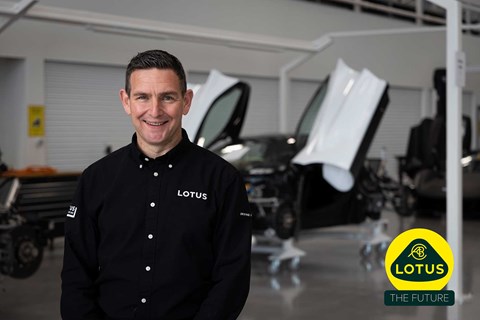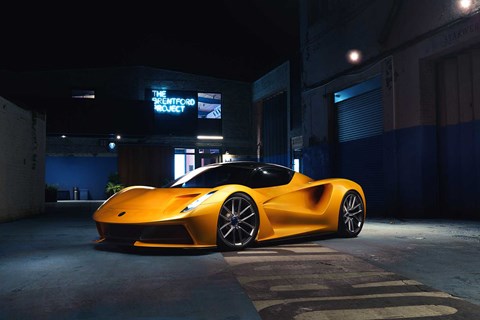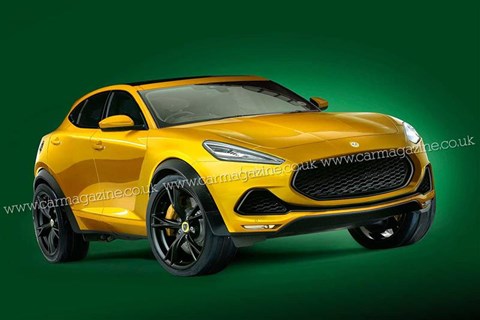► Lotus' future electric car range revealed
► Plus world's first interview with boss, Matt Windle
► First details of Lotus SUV on 'lifestyle' vehicle platform
Lotus is going global, with a new headquarters for its Technology division being built in Wuhan, China. This new HQ will be a cornerstone in developing its all-in focus on pure electric cars, along with a massive £100m-plus investment in its Hethel headquarters and engineering capabilities. This new fleet of pure-EV Lotus models includes two new SUVs and a sports saloon.
CAR gained a world exclusive interview earlier in 2021 with new Lotus Cars managing director, Matt Windle, where he reveals that the brand's future sports cars will all be electric, Chinese-built 'lifestyle vehicles' will also be zero-emission, and the brand is developing its own platforms – rather than relying on Geely ones.
Check this story's links for more on the future of Lotus, but read on for key details of the company's electrification plan.
Electric at the heart of Lotus's 10-year plan
Matt Windle has been managing director since January 2021, though he began his second stint at Lotus in 2017 – the same year Lotus came under the majority ownership of China's answer to the Volkswagen Group, Geely Holdings, and Malaysian car group Etika Automotive (which holds the other 49%). The new owners have pumped more than £100m into Lotus, including the construction of a new assembly hall at Hethel (pictured below).
Soon Windle was in charge of all UK product development, and intrinsically involved in writing Lotus's 10-year business plan out to 2028, the company's eightieth year.

'When we wrote our product strategy, which was the start of the Vision80 plan, we just had to write EV into that,' explains the 49-year-old boss. 'With the legislation that's come along, with the market data showing volumes are just going to grow and grow: the move towards electrification, it's the right thing to do.'
Windle is no stranger to EVs: he worked at Tesla for seven years, getting the first Roadster into production at Hethel. 'It made me realise what you can do with electric cars. They come with their challenges but also a lot of benefits: heat management, packaging, and if you put the batteries at the bottom, a car's centre of gravity is much lower.'
The Emira: the last combustion-engined Lotus
Lotus has already shown the first car of the Vision80 plan, the Evija (below), a carbonfibre-monocoque-based pure-electric hypercar. Its four motors are claimed to produce a combined 2000PS (1973bhp), which would make it the most powerful road car in history. The price tag? £2m a pop.

While the Evija is limited to 130 units (as befits its 130 type number), the Emira – internally known as Type 131 before its reveal – is the first series-production model of the new era.
'We're not doing any hybrid drivetrains, because we're going straight to electric,' states Matt Windle. 'Type 131 is basically the bridge to the new era of Lotus cars: it's our last internal-combustion-engine car.'
Emira is a mid-engined sports car to replace the outgoing Elise/Exige/Evora. It'll enter Lotus's revamped retailers in early 2022.
Lotus SUVs on bespoke vehicle architecture
Also in development are two new vehicle architectures, one to support four-door 'lifestyle vehicles' such as crossover/SUVs, the other to underpin pure-electric sports cars. Neither is planned to accommodate combustion engines – and they are engineered by Lotus. Two new SUVs will arrive – one for the E segment (Porsche Cayenne, BMW X5, Audi Q7 etc.) in 2022 and one for the D segment in 2025 (Alfa Stelvio, Porsche Macan, Maserati Grecale etc.).
Lotus SUV mule spotted
What's Windle's vision for such a car? 'The aesthetics have to be right, it has to be desirable. It has to drive like a Lotus, even if there's more weight and it's bigger. There's no reason why you can't have best handling and dynamics.'

'We're not using Geely architectures,' explains Windle. 'We have access to those architectures, but one of the things which shows the intent for Lotus is that we're designing our own architectures. [One of those] will be a lifestyle car architecture.' On top of the SUVs, another car to use this will be an E segment saloon (BMW 5-series, Audi A6 etc.) coming in 2024.
Revealed: Lotus's global expansion plans – and keen price for next sports car
Lotus will glean some insights from partnering with Jenson Button's Extreme E race team: it's an appropriate crucible for the new Lotus, mixing motorsport, off-road vehicles and pure-electric power.
And a pure-electric sports car – in tandem with Alpine
Also in the pipeline is a pure-electric sports car architecture. 'We have a programme running called LEVA (lightweight electric vehicle architecture), with government backing,' says Windle. 'We have ambitions to get an electric sports car to a similar weight to where combustion-engine sports cars are now.'
Discussing LEVA, Windle's passion for engineering shines through. He started as a manual draftsman at camper van maker Dormobile, then learned computer-aided design at Daewoo in Worthing before joining Lotus for the first time in 1998.
'We think we can [achieve our goal] through clever design, integration of systems – at Lotus we have our really happy moments if we get one part to do two jobs!' Innovative materials will also play a part.

One of LEVA's beneficiaries will be Renault's sports-car division Alpine. The two companies are exploring shared technical resources and looking at combined motorsport opportunities. 'The main one is co-developing a sports car together, which will be based off the electric sports-car platform we have in design now,' says the boss.
He'll be vital in developing the relationship between Alpine and Lotus: he knows his French counterparts well, having worked for Caterham when it was trying to develop a version of the A110 sports car (below). Unfortunately a lack of funding killed the Caterham.
'I think Lotus and Alpine fit very well together: we're of the same mentality, the same aspirations. And we kind of complement each other in market spaces as well: they could help us in Europe, and we could help them in the US. So I think there are really good opportunities there for both brands,' concludes Windle.